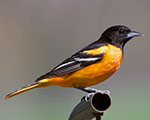vx.Vx image container
Constructor
class vx.Vx(image-reference) Image class containing image and meta dataParameter: image-reference : one of file-name, vx.Vx class, array, PIL-Image.
Contains an image with two or three dimensions (and optionally multiple channels) in an numpy.array with additional metadata.
class vx.Vx() Create a null Vx structure
class vx.Vx('data-type',bbx-tupple,num-channels) Create an image with zero pixel values
Returns: Initialized vx.Vx structure
Attributes and underlying data
- Vx.i
- The image np.array
- Vx.h
-
The metadata
- Vx.c
- The number of channels in each pixel
Functions
- Vx.setim(<numpy.array> ).
- Set the image to the numpy.array
- Vx.embedim(<border list tuple>).
- Embed image numpy.array with border of zero's
- Vx.write(filename)
- Write image and metadata to a file
Examples
1. Vx construction from image file
from v4 import vx
from v4 import vd
from numpy import np
sb = vx.Vx("isbird.vx")
print (sb)
vd.dispvx (sb)
VisionX V4: Vx
Image Size: (120, 150, 3)
Pixel Type: uint8
Number of channels: 3

2. Vx construction with pixel values set to zero
print('2D single channel')
vim = vx.Vx('uint8',(0,5,0,2))
print (vim)
print (vim.i)
2D single channel
VisionX V4: Vx
Image Size: (2, 5)
Pixel Type: uint8
Number of channels: 1
[[0 0 0 0 0]
[0 0 0 0 0]]
print('3D multichannel')
vim = vx.Vx('float32',(2,4,3),5)
print (vim)
print (vim.i)
3D multichannel
VisionX V4: Vx
Image Size: (3, 4, 2, 5)
Pixel Type: float32
Number of channels: 5
[[[[0. 0. 0. 0. 0.]
[0. 0. 0. 0. 0.]]
[[0. 0. 0. 0. 0.]
[0. 0. 0. 0. 0.]]
[[0. 0. 0. 0. 0.]
[0. 0. 0. 0. 0.]]
[[0. 0. 0. 0. 0.]
[0. 0. 0. 0. 0.]]]
[[[0. 0. 0. 0. 0.]
[0. 0. 0. 0. 0.]]
[[0. 0. 0. 0. 0.]
[0. 0. 0. 0. 0.]]
[[0. 0. 0. 0. 0.]
[0. 0. 0. 0. 0.]]
[[0. 0. 0. 0. 0.]
[0. 0. 0. 0. 0.]]]
[[[0. 0. 0. 0. 0.]
[0. 0. 0. 0. 0.]]
[[0. 0. 0. 0. 0.]
[0. 0. 0. 0. 0.]]
[[0. 0. 0. 0. 0.]
[0. 0. 0. 0. 0.]]
[[0. 0. 0. 0. 0.]
[0. 0. 0. 0. 0.]]]]